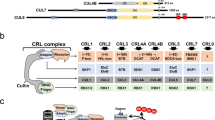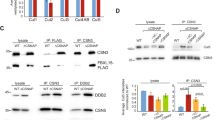Abstract
Cullin 1/CDC53 represents a multigene family and has been linked to the ubiquitin-mediated proteolysis of several different proteins. We recently identified two closely related RING finger proteins, ROC1 and ROC2, that share considerable sequence similarity to an APC subunit, APC11, and demonstrated ROC1 as an essential subunit of CUL1 and CDC53 ubiquitin ligases. We report here that the expression of ROC1, ROC2 and APC11 genes are induced by mitogens and remain constant during the cell cycle. Unlike other subunits of SCF and APC E3 ligases, ectopically expressed ROC family proteins are degraded by a proteasome-inhibitor sensitive pathway and are stabilized by associating with cullins. Mutations at the conserved Phe79 and His80 residues in the RING finger of ROC1 diminish its binding with cullins, resulting in a loss of cullin protection and ubiquitin ligase activity. These results suggest a potential mechanism for regulating the activity of ROC-cullin ligases through complex assembly and ROC/APC11 subunit ubiquitination.
This is a preview of subscription content, access via your institution
Access options
Subscribe to this journal
Receive 50 print issues and online access
$259.00 per year
only $5.18 per issue
Buy this article
- Purchase on Springer Link
- Instant access to full article PDF
Prices may be subject to local taxes which are calculated during checkout






Similar content being viewed by others
References
Bai C, Sen P, Hofmann K, Ma L, Goebl M, Harper JW and Elledge SJ. . 1996 Cell 86: 263–274.
Feldman RMR, Correll CC, Kaplan KB and Deshaies RJ. . 1997 Cell 91: 221–230.
Hershko A. . 1997 Curr. Opin. Cell Biol. 9: 788–799.
Hochstrasser M. . 1996 Annu. Rev. Genet. 30: 405–439.
Huibregtse JM, Schneffner M, Beaudenon S and Howley PM. . 1995 Proc. Natl. Acad. Sci. USA 92: 2563–2567.
Jenkins CW and Xiong Y. . 1995 In: Cell Cycle: Material and Methods, Pagano, M. (ed.) New York: Springer-Verlag. pp. 250–263.
Jentsch S. . 1992 Annu. Rev. Genet. 26: 179–207.
Kamura T, Koepp DM, Conrad MN, Skowyra D, Moreland RJ, Iliopoulos O, Lane WS, Kaelin WG Jr., Elledge SJ, Conaway RC, Harper JW and Conaway JW. . 1999 Science 284: 657–661.
King R, Peters J, Tugendreich S, Rolfe M, Hieter P and Kirschner M. . 1995 Cell 81: 279–288.
King RW, Deshaies RJ, Peters J-M and Kirscher MW. . 1996 Science 274: 1652–1659.
Kipreos ET, Lander LE, Wing JP, He W-W and Hedgecock EM. . 1996 Cell 85: 829–839.
Laney JD and Hochstrasser M. . 1999 Cell 97: 427–430.
Li Y, Jenkins CW, Nichols MA and Xiong Y. . 1994 Oncogene 9: 2261–2268.
Maniatis T. . 1999 Genes Dev. 13: 505–510.
Marti A, Wirbelauer C, Scheffner M and Krek W. . 1999 Nature Cell Biol. 1: 14–19.
Mathias N, Johnson SJ, Winey M, Adams AEM, Goetsch L, Pringle JR, Byers B and Gobel MG. . 1996 Mol. Cell Biol. 16: 6634–6643.
Mathias N, Johnson S, Byers B and Goebl M. . 1999 Mol. Cell Biol. 19: 1759–1767.
Michel J and Xiong Y. . 1998 Cell Growth. Differ. 9: 439–445.
Ohta T, Michel JJ, Schottelius AJ and Xiong Y. . 1999 Mol. Cell 3: 535–541.
Patton EE, Willems AR and Tyers M. . 1998 Trends Genetics 768: 236.
Schwob E, Bohm T, Mendenhall MD and Nasmyth K. . 1994 Cell 79: 233–244.
Seol JH, Feldman RM, Zachariae W, Shevchenko A, Correll CC, Lyapina S, Chi Y, Galova M, Claypool J, Sandmeyer S, Nasmyth K, Deshaies RJ. . 1999 Genes Dev. 13: 1614–1626.
Skowyra D, Craig K, Tyers M, Elledge SJ and Harper JW. . 1997 Cell 91: 209–219.
Skowyra D, Koepp DM, Kamura T, Conrad MN, Conaway RC, Conaway JW, Elledge SJ and Harper JW. . 1999 Science 284: 662–665.
Sudakin V, Ganoth D, Dahan A, Heller H, Hershko J, Luca FC, Ruderman JV and Hershko A. . 1995 Mol. Biol. Cell 6: 185–197.
Tan P, Fuches SY, Angus A, Wu K, Gomez C, Ronai Z and Pan Z-Q. . 1999 Mol. Cell 3: 527–533.
Verma R, Annan RS, Huddleston MJ, Carr SA, Reynard G and Deshaies RJ. . 1997 Science 278: 455–460.
Willems AR, Lanker S, Patton EE, Craig KL, Nason TF, Mathias N, Kobayashi R, Wittenberg C and Tyers M. . 1996 Cell 86: 453–463.
Yaron A, Hatzubai A, Davis M, Lavon I, Amit S, Manning AM, Andersen JS, Mann M, Mercurio F and Bem-Neriah Y. . 1998 Nature 396: 590–594.
Yu H, Peters J-M, King RW, Page AM, Hieter P and Kirschner MW. . 1998 Science 279: 1219–1222.
Zachariae W, Shevchenko A, Andrews PD, Ciosk R, Galova M, Stark MJR, Mann M and Nasmyth K. . 1998 Science 279: 1216–1219.
Zhang H, Kobayashi R, Galaktionov K and Beach D. . 1995 Cell 82: 915–925.
Zhou P and Howley PM. . 1998 Mol. Cell 2: 571–580.
Acknowledgements
T Ohta is supported in part by the Department of Surgery, St Marianna University School of Medicine. JJ Michel is supported by an US Department of Defense Breast Cancer Research Program pre-doctoral fellowship. Y Xiong is a recipient of American Cancer Society Junior Faculty Award and a Pew Scholar in Biomedical Science. This study was supported by Public Health Service grants CA65572 and CA68377 to Y Xiong.
Author information
Authors and Affiliations
Rights and permissions
About this article
Cite this article
Ohta, T., Michel, J. & Xiong, Y. Association with cullin partners protects ROC proteins from proteasome-dependent degradation. Oncogene 18, 6758–6766 (1999). https://doi.org/10.1038/sj.onc.1203115
Received:
Revised:
Accepted:
Published:
Issue Date:
DOI: https://doi.org/10.1038/sj.onc.1203115
Keywords
This article is cited by
-
Induction of NEDD8-conjugating enzyme E2 UBE2F by platinum protects lung cancer cells from apoptosis and confers to platinum-insensitivity
Cell Death & Disease (2020)
-
Identification and characterization of an E3 ubiquitin ligase Rbx1 in maize (Zea mays L.)
Plant Cell, Tissue and Organ Culture (PCTOC) (2014)
-
Genetically engineered mouse models for functional studies of SKP1-CUL1-F-box-protein (SCF) E3 ubiquitin ligases
Cell Research (2013)
-
Granulocytic differentiation of HL-60 promyelocytic leukemia cells is associated with increased expression of Cul5
In Vitro Cellular & Developmental Biology - Animal (2009)



